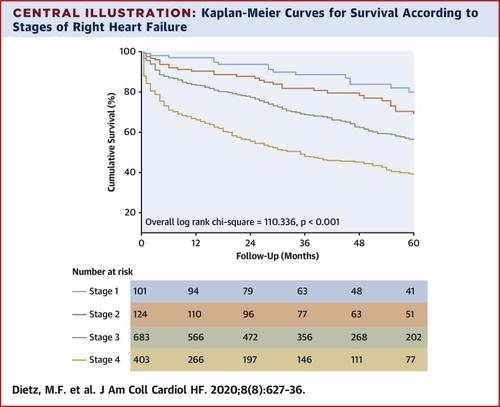JACC: Heart Failure ( IF 10.3 ) Pub Date : 2020-06-10 , DOI: 10.1016/j.jchf.2020.02.008 Marlieke F Dietz 1 , Edgard A Prihadi 2 , Pieter van der Bijl 1 , Nina Ajmone Marsan 1 , Victoria Delgado 1 , Jeroen J Bax 1

|
Objectives
The purpose of this study was to evaluate the prognostic value of staging right heart failure (RHF) in patients with significant secondary tricuspid regurgitation (TR).
Background
Right ventricular dysfunction (RVD), defined as tricuspid annular plane systolic excursion <17 mm and clinical signs of RHF, defined as New York Heart Association functional class ≥II, peripheral edema, or use of diuretics, do not always coincide in patients with significant secondary TR and may have different prognostic implications.
Methods
A total of 1,311 patients with significant secondary TR (median age: 71 [interquartile range: 62 to 78] years; 50% male) were divided into 4 RHF Stages according to the presence or absence of RVD and clinical signs of RHF: Stage 1 was defined as no RVD and no signs of RHF; Stage 2 indicated RVD but no signs of RHF; Stage 3 included RVD and signs of RHF; Stage 4 was defined as RVD and refractory signs of RHF at rest. Five-year mortality rates were compared across the 4 Stages of RHF, and the independent associates of mortality were identified by using multivariate Cox proportional hazards models.
Results
A total of 101 patients (8%) were classified as Stage 1, 124 (10%) as Stage 2, 683 (52%) as Stage 3, and 403 (31%) as Stage 4. Patients in higher Stages of RHF had more comorbidities and worse renal and left ventricular systolic function. Cumulative 5-year survival was 54%. RHF Stages 3 and 4 were independently associated with increased mortality compared to Stage 1 (hazard ratio: 2.110 [95% confidence interval (CI): 1.163 to 3.828] and 3.318 [95% CI: 1.795 to 6.133], respectively).
Conclusions
In patients with significant secondary TR, higher Stages of RHF are independently associated with all-cause mortality at long-term follow-up.
中文翻译:

严重继发性三尖瓣关闭不全患者分期右心衰竭的预后意义。
目标
这项研究的目的是评估右心衰竭(RHF)分期对继发性三尖瓣反流(TR)的患者的预后价值。
背景
右心功能不全(RVD)定义为三尖瓣环平面收缩期<17 mm,RHF的临床体征定义为纽约心脏协会功能等级≥II,外周水肿或使用利尿剂,在患有严重心律失常的患者中并不总是重合继发性TR,可能有不同的预后影响。
方法
根据是否存在RVD和RHF的临床体征,将总共1,311例具有重大继发性TR(中位年龄:71 [四分位数范围:62至78]岁;男性占50%)的患者分为4个RHF阶段:被定义为无RVD,无RHF征象;第2阶段显示RVD,但无RHF征象。第三阶段包括RVD和RHF体征;第4阶段定义为RVD和静止时RHF的难治性体征。比较了RHF四个阶段的五年死亡率,并使用多元Cox比例风险模型确定了独立的死亡率相关因素。
结果
共有101例患者(8%)被分类为1期,124(10%)被归为2期,683(52%)被归为3期,403(31%)被归为4期。合并症多,肾和左心室收缩功能差。5年累计生存率为54%。与第1阶段相比,RHF第3和第4阶段与死亡率增加独立相关(危险比:2.110 [95%置信区间(CI):1.163至3.828]和3.318 [95%CI:1.795至6.133])。
结论
在具有大量继发性TR的患者中,长期随访发现,较高的RHF分期与全因死亡率无关。











































 京公网安备 11010802027423号
京公网安备 11010802027423号